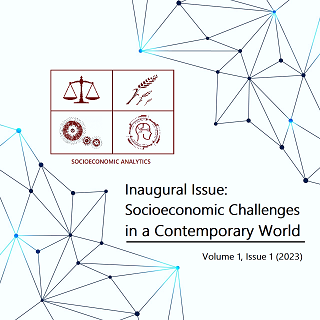Parametric and non-parametric data-driven analytics for socioeconomic challenges in a contemporary world
DOI:
https://doi.org/10.51359/2965-4661.2023.259300Keywords:
Data Analytics, Econometrics, Operations Research , Data Envelopment Analysis, Time Series Analysis, regression models, Natural Language Processing, Sentiment AnalysisAbstract
The rapid advancement of artificial intelligence and data-driven technologies have presented novel opportunities for addressing complex socioeconomic challenges in the contemporary world. By harnessing diverse datasets and employing sophisticated analytical techniques, researchers, policymakers, and practitioners can gain profound insights into the root causes of socioeconomic challenges and devise innovative strategies to promote inclusive development and sustainable growth. In this editorial, I share some perspectives on exploring the application of non-parametric and parametric data-driven analytics methodologies (Data Envelopment Analysis and Econometric Models) as powerful tools for understanding and resolving multifaceted issues that impact societies globally, and what I believe to be the future of these methods. Readers of Socioeconomic Analytics will be able to find those interesting methodologies as empirical applications in the journal's inaugural and forthcoming issues.References
Aigner, D., Lovell, C. K., & Schmidt, P. (1977). Formulation and estimation of sto-chastic frontier production function models. Journal of econometrics, 6(1), 21-37.
Blazquez, D., & Domenech, J. (2018). Big Data sources and methods for social and economic analyses. Technological Forecasting and Social Change, 130, 99-113.
Charnes, A., Cooper, W. W., & Rhodes, E. (1978). Measuring the efficiency of deci-sion making units. European journal of operational research, 2(6), 429-444.
Ciuffetelli Parke,r D. and Conversano, P. (2021). Narratives of Systemic Barriers and Accessibility: Poverty, Equity, Diversity, Inclusion, and the Call for a Post-Pandemic New Normal Frontiers in Education, 6:704663. doi: 10.3389/feduc.2021.704663
Daraio, C., & Simar, L. (2007). Conditional nonparametric frontier models for con-vex and nonconvex technologies: a unifying approach. Journal of productivity anal-ysis, 28, 13-32.
Farrell, M. J. (1957). The measurement of productive efficiency. Journal of the Roy-al Statistical Society Series A: Statistics in Society, 120(3), 253-281.
Nepomuceno, T. C. C., & Costa, A. P. C. S. (2019). Resource allocation with time series DEA applied to Brazilian federal saving banks. Economics Bulletin, 39(2), 1384-1392.
Nepomuceno, T. C. C., Costa, A. P. C. S., & Daraio, C. (2023). Theoretical and Em-pirical Advances in the Assessment of Productive Efficiency since the introduction of DEA: A Bibliometric Analysis. International Journal of Operational Rese-arch, 46(4), 505-549.
Nepomuceno, T. C. C., de Moura, J. A., e Silva, L. C., & Costa, A. P. C. S. (2017). Alcohol and violent behavior among football spectators: An empirical assessment of Brazilian's criminalization. International journal of law, crime and justice, 51, 34-44.
Downloads
Additional Files
Published
Issue
Section
License
Copyright (c) 2023 Thyago C. C. Nepomuceno

This work is licensed under a Creative Commons Attribution-NonCommercial-NoDerivatives 4.0 International License.
Authors who publish with Socioeconomic Analytics retain the copyright of their work and agree to license it under a Creative Commons Attribution-NonCommercial-NoDerivatives 4.0 International (CC BY-NC-ND 4.0) license. This means that the work can be shared, copied, and redistributed in any medium or format, as long as it is not used for commercial purposes, and the original work is properly cited. The work cannot be changed in any way or used to create derivative works.










